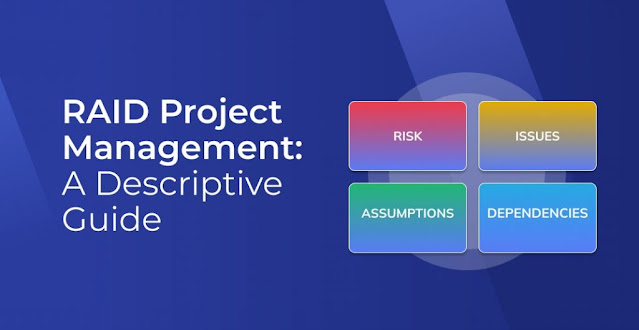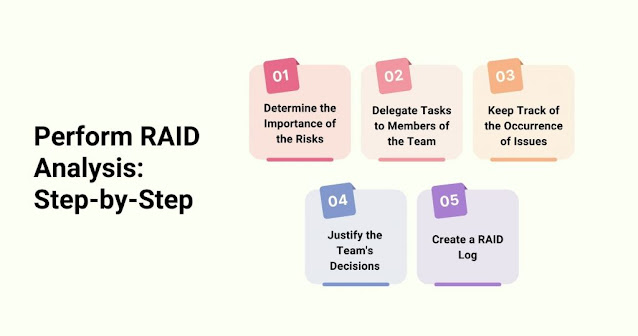Monday, 30 October 2023
RAID Project Management: A Descriptive Guide
Friday, 27 October 2023
Project Management Career: A Pathway to Success
The Rise of Project Management
The Significance of Project Managers
Key Skills for a Project Manager
Career Prospects in Project Management
Transitioning to a Project Management Career
Wednesday, 25 October 2023
Unveiling ITIL Guiding Principles: A Roadmap to Operational Excellence
The Essence of ITIL
Understanding the Guiding Principles
Why ITIL Guiding Principles Matter
Final Thoughts
Monday, 23 October 2023
Unlocking Success: Navigating Your ITIL Career
In today's digital age, the Information Technology Infrastructure Library (ITIL) plays a pivotal role in the efficient management of IT services. ITIL is a set of best practices that ensures that IT services are aligned with the needs of businesses. In this comprehensive guide, we will delve into the world of ITIL, its significance in the corporate world, and how you can propel your ITIL career to new heights.
The Foundation of ITIL
What is ITIL?
ITIL stands for Information Technology Infrastructure Library, and it serves as a framework of best practices for IT service management. It was developed by the United Kingdom's Office of Government Commerce (OGC) and has evolved into a global standard for IT service management.
The Pillars of ITIL
1. Service Strategy
Service strategy is the first step in ITIL. It involves understanding your business objectives and customer needs, and then devising a strategy to meet them. Successful implementation of service strategy can lead to enhanced customer satisfaction and financial gains for your organization.
2. Service Design
Service design encompasses the planning and design of IT services. It ensures that the services are efficient, cost-effective, and meet the business needs. Effective service design is essential for delivering high-quality IT services.
3. Service Transition
Service transition focuses on the smooth transition of services from development to production. It minimizes disruption to the business while introducing new or modified services, ensuring that the changes are implemented with minimal risk.
4. Service Operation
Service operation is the day-to-day management of IT services. It involves activities such as incident management, problem management, and continuous service improvement. This stage ensures the services are delivered efficiently and effectively.
5. Continual Service Improvement
Continual service improvement is all about optimizing IT services over time. It involves regular assessments, reviews, and adjustments to ensure that services align with changing business needs and industry trends.
The Significance of ITIL in the Corporate World
In today's fiercely competitive business landscape, ITIL is not just a buzzword; it's a necessity. Here's why ITIL is so crucial for organizations:
Improved Service Quality
By implementing ITIL practices, organizations can provide more reliable and efficient services to their customers. This results in higher customer satisfaction and improved reputation.
Cost Efficiency
ITIL helps in optimizing IT processes, leading to cost reductions. Through better resource allocation and streamlined processes, organizations can maximize their ROI.
Enhanced Collaboration
ITIL promotes collaboration and communication between different departments within an organization. This not only improves service delivery but also fosters a culture of teamwork.
Regulatory Compliance
In an increasingly regulated environment, ITIL helps organizations adhere to compliance requirements. It ensures that data and services are handled in a secure and compliant manner.
Advancing Your ITIL Career
Now that you understand the significance of ITIL in the corporate world, let's discuss how you can advance your ITIL career:
1. Certifications
Earning ITIL certifications is a surefire way to enhance your career prospects. Start with the ITIL Foundation certification and progress to more advanced levels. These certifications not only boost your knowledge but also demonstrate your commitment to ITIL best practices.
2. Continuous Learning
ITIL is a dynamic field, and staying updated is crucial. Read books, attend webinars, and participate in ITIL user groups to expand your knowledge and network with like-minded professionals.
3. Hands-On Experience
Practical experience is invaluable. Work on real-world ITIL projects to apply your knowledge and gain practical insights into IT service management.
4. Soft Skills
In addition to technical expertise, soft skills such as communication, leadership, and problem-solving are essential. They will set you apart in the competitive job market.
5. Networking
Build a strong professional network by connecting with ITIL practitioners, attending industry conferences, and engaging in online forums. Networking can open doors to new opportunities and collaborations.
Conclusion
ITIL is the backbone of efficient IT service management, and it plays a critical role in achieving business goals. To thrive in your ITIL career, focus on certifications, continuous learning, practical experience, soft skills, and networking. By embracing these principles, you can unlock the doors to a successful and fulfilling ITIL career.
Friday, 20 October 2023
Mastering the ISQI Exam: Your Gateway to Success
Understanding the ISQI Exam
The Significance of ISQI Certification
Preparing for the ISQI Exam
The Exam Day
After the Exam
Wednesday, 18 October 2023
PMP Certification Prerequisites: Your Path to Success
Introduction
Understanding the PMP Certification
PMP Certification Prerequisites
Preparing for the PMP Exam
Applying for the PMP Exam
Friday, 13 October 2023
Understanding Lean Six Sigma: A Comprehensive Guide
What is Lean Six Sigma?
The Synergy of Lean and Six Sigma
Key Benefits of Implementing Lean Six Sigma
Lean Six Sigma in Practice
Wednesday, 11 October 2023
PMP Certification: The Golden Ticket to Project Management Stardom
The Power of PMP Certification
The Journey to PMP Certification
- A four-year degree with three years of project management experience.
- A secondary degree (high school diploma, associate's degree) with five years of project management experience.
PMP Certification and Your Career
- Project Manager
- Program Manager
- Portfolio Manager
- Business Analyst
- Quality Assurance Manager
- Risk Manager
Friday, 6 October 2023
CQA Certification: Expand Your Career
In today's competitive job market, professionals in the quality auditing field are constantly seeking ways to stand out and advance their careers. One surefire way to achieve this is by obtaining the ASQ Certified Quality Auditor (CQA) certification. This prestigious certification offers many benefits to help you excel in your auditing career and open doors to exciting opportunities. This comprehensive blog will explore the benefits of the ASQ CQA certification.
A Certified Quality Auditor is a skilled expert with knowledge of auditing standards, principles, and techniques. They are proficient in scrutinizing, questioning, assessing, and reporting on a quality system's effectiveness, identifying its strengths and weaknesses. The Certified Quality Auditor thoroughly evaluates every aspect of a quality system and assesses how well it aligns with the criteria of industrial management and quality assessment and control systems.
Eligibility to Take the ASQ CQA Certification Exam:
- 8 years of extensive practical experience gained through employment in one or more domains covered by the Certified Quality Auditor Body of Knowledge. Or,
- 3 years of on-the-job experience should be in a role involving "decision-making.
Here Are the Career Benefits for the ASQ CQA Certification:
ASQ CQA Certification Earns You Value from Employers:
One of the most significant benefits of earning the ASQ CQA certification is its boost to your job prospects. Employers value certification and many job postings for quality auditor positions require or prefer CQA certified candidates. Certified quality auditors often command higher salaries than their non-certified counterparts. The CQA certification demonstrates your expertise and commitment to quality, making you an attractive candidate for higher-paying positions.
Earning the CQA certification is a testament to your competence as a quality auditor. It provides instant credibility in the eyes of employers, colleagues, and clients, enhancing your professional reputation.
PRINCE2 Practitioner Certification: Uncover the Reasons to Grab Yours!
Improve Your Knowledge and Skills:
The CQA certification covers many knowledge areas, including quality management principles, auditing techniques, and regulatory requirements. This comprehensive knowledge equips auditors to excel in their roles. CQA candidates develop critical auditing skills through rigorous training and examination, such as conducting effective audits, identifying non-conformities, and recommending corrective actions. These skills are invaluable in the quality auditing profession.
The knowledge and skills acquired through CQA certification are transferable and can be applied in various industries and roles. Whether in manufacturing, healthcare, or any other sector, the CQA certification equips you to excel and drive continuous improvement.
Earn the Global Recognition:
ASQ is a well-respected organization in the quality field, and its certifications are highly regarded worldwide. Being affiliated with ASQ enhances the credibility of CQA-certified auditors.
The ASQ CQA certification is not limited to a specific region or country. Its global recognition means you can pursue opportunities in different parts of the world with confidence in your certification's value.
The CQA certification symbolizes trust and competence for employers and clients seeking quality auditors. It assures them that the auditor possesses the necessary skills to ensure product and process quality.
Expanded Network Opportunities with ASQ CQA:
ASQ offers certified auditors access to a vast network of like-minded professionals. The network can be leveraged for knowledge sharing, career guidance, and professional growth.
ASQ hosts numerous events, conferences, and online forums where certified auditors can connect with industry experts and peers. These networking opportunities can lead to valuable insights and collaborations.
Building relationships within the ASQ community can open doors to mentorship and career advancement. It's a platform for sharing best practices and updating industry trends.
Keep Up with Industry Standards:
Quality standards and regulations evolve. CQA-certified auditors are equipped to stay current with these changes, ensuring that organizations adhere to the latest industry norms.
ASQ continually updates its certification materials to align with industry changes. CQA-certified auditors are well-prepared to navigate these changes and help organizations maintain compliance.
By staying up-to-date with industry standards, CQA-certified auditors contribute to organizational success by preventing compliance issues and driving continuous improvement.
Do Self-improvement through ASQ CQA Certification:
The process of earning the CQA certification is a journey of self-improvement. It challenges individuals to expand their knowledge, refine their skills, and push their boundaries.
Certified quality auditors develop strong problem-solving abilities through their training. This newfound confidence and analytical mindset benefit auditors in both their professional and personal lives.
Personal growth and development enhance an auditor's career and improve their overall quality of life. The skills acquired during certification are valuable in various aspects of life.
Contribute to Organizational Success:
CQA-certified auditors play a crucial role in improving organizational performance by identifying areas for improvement, reducing defects, and ensuring compliance with quality standards.
Companies that employ CQA-certified auditors benefit from enhanced product and service quality, which can lead to increased customer satisfaction and profitability.
Numerous success stories highlight the positive impact that CQA-certified auditors have had on organizations, reinforcing the value of this certification.
Concluding Thoughts:
The ASQ Certified Quality Auditor certification offers many advantages for professionals in the quality auditing field. From improved job prospects and higher earning potential to personal growth and industry recognition, the CQA certification is a game-changer. Becoming a CQA-certified auditor is a wise choice if you aspire to excel in quality auditing and contribute to organizational success. Join the ranks of certified auditors who have made a difference and embark on your journey toward excellence.
Incorporating the ASQ CQA certification into your career path can elevate you to new heights, ensuring that you leave other websites behind in your pursuit of excellence in quality auditing. Begin your journey today and make a lasting impact in the world of quality and auditing.
How could your organisation benefit from the new PRINCE2 7 ‘commercial management approach’?
The new ‘commercial management approach’ in PRINCE2 7
How will the commercial management approach benefit individuals and organisations?
- Increase success rates: Encouraging project managers to consider cost controls and budget management throughout will help a project to remain in line with financial requirements and meet objectives
- Optimise resource procurement and allocation: The new management approach will help to ensure that all resources are fit for purpose, economical and sustainable, and that they are allocated correctly
- Maximise value: Using the commercial management approach will help project managers to identify opportunities to minimise costs without compromising the product or service quality
- And more!















